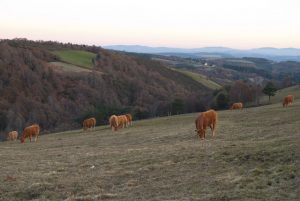Article translated by an automatic translation system. Press here for further information.
Grandas de Salime a Fonsagrada
The road starts to soak from Gestoselo to Peñafonte
Information about the stage 7: Grandas de Salime a Fonsagrada

Enlarge map
The route
Important warnings! : In Paradanova (Km 24,4), someone has indicated A Fonsagrada on the Mojón route to A Pobra de Burón and there are already several groups of pilgrims who have been lost. Once in Paradanova, seeing A Fonsagrada at a height of several hundred meters, you have to follow the cairn that is located on the left of the road, which ascends the camín da Granxa to A Fonsagrada.
The public hostel of Padrón, located behind A Fonsagrada, is CLOSED. The new Xunta hostel located in the same center of A Fonsagrada and opened in summer 2017 is now serving
.
- Km 0. Grandas de Salime (All services)
We returned from the hostel to the former collegiate of San Salvador. Pascual Madoz, in his geographic, statistical, historical dictionary, reviews that of this temple "says with some foundation that belonged to the Templars and that perhaps there would be in this villa a host for pilgrims who attended to visit the tomb of Santiago". We immediately crossed the road and took the street where the chapel of Carmen is located in the 18th century and linked to the lineage of the Alvarez de Linera. In the posterior bifurcation we continue on the left and advance on a bose path and under the stand attached to AS-28. We left this one at the height of the farmhouse of A Farrapa (Km 1,2). Later on we passed the detour to Scanlares and Robledo and to some dairy industries. Past the curve we crossed the AS-28 and continued on a track, passing through Xuntacasa and arriving at Cereixeira, where there are a couple of bars: Casa Federico y La Parrilla.
- Km 3.2. Cereixeira (Bars)
At the exit of Cereixeira we take another herbose path that leads after several turns to the chapel of La Esperanza (Km 4,5). The village of Malneira is on the right hand. From here to Castro happens a section under a stand and a paved track that leads to the youth hostel managed by Sandra, Juan and Natalia.
- Km 5.5. Castro (Bar-Restaurant-Hostel. Hotel)
Next to the population is the Castro of Chao Samartín, settlement of the Bronze Age dated 800 BC. We went by the rural church and the Chao Samartín hotel and crossed a road, leaving this core. We go back to the roads. We left Padraira to the left and later we met the chapel of San Lázaro, old lazareto (Km 7.1). About 10 minutes later we go back to AS-28 and pass Gestoon.
- Km 7.9. Bear it
Although at the moment, from here the ascent to the port of Acebo began to be more evident. We cover by road the 2,2 kilometer stretch that separates us from Peñafonte, the last Asturian nucleus we will visit. At the entrance we leave the asphalt to climb to the church of Santa María Magdalena, whose porticated atrium invites to rest. Next to the temple is the fountain, so let us not forget to take a drink and fill the container. We will still have to exceed over 250 meters of slope to the 1,110 level.
- Km 10.1. Peñafonte
We do not return to the road but continue to climb the hillside of Mount Zarro. Except for the first ramps, it's a pretty bearable stretch. We re-entered the AS-28 and crossed it to Bustelo del Camín. Next, at the foot of the access road, we open a portilla and take the path that advances between the tojo. The climb to Monte da Curiscada requires more effort, even more planting before the wind turbine line. After passing another portilla we killed the last meters of ascension (Km 13).
At an unfixed point, after the first sight of Fonsagrada, still more than 12 kilometres away, we say goodbye to Asturias to receive Galicia. To the south, to the left, a couple of kilometers in a straight line, is the Sierra de Piedras Apañadas, named so, perhaps, as reflected by Uría in Las Peregrinaciones to Santiago de Compostela, because there would be a lot of stones deposited by the walkers, as on the Cross of Ferro. At the front is Fonsagrada, far over 12 kilometers. We go down to the road next to the sale of Acebo, where the first Galician indicator is located. Unlike in Asturias, we do not agree on this!
- Km 14.5. Sale of Acebo (Bar-Shop)
Behind the Sale, whose schedules are unpredictable, is a road filled with acebos (Ilex aquifolium), showing the toponym. After a brief re-run, the track approached the LU-701 and advanced in parallel, thus reaching Cabreira, the place of the parish of Monteseiro, already belonging to the cello of A Fonsagrada.
- Km 16.5. Cabreira
The runway continues next to the road after Fonfries. Just before the nucleus, we went by the twinkling source. He was commissioned by the Order of the Sanjuanist Knights and maintained a Hospital.
- Km 18.6. Fonmelo
Next to the last houses we turn left and continue on a compact track, where one of the Jacobean stones points at 165,990 kilometers to Santiago. For a while we forget the road passing through Mount Penoucos. This last section dies again in the LU-701 at the height of Barbeitos. Here is the Catro Ventos Plateau, a good place to taste meats and specialties of the area.
- Km 20,2. Barbeitos (Mesón)
In Barbeitos we cross the road and follow a trail that moves along the line of a pine tree to Silvela, a place in the parish of San Martín de Suarna. Here we cross the LU-701 and then reach the hermitage of Santa Barbara. Right above there is a viewpoint and a bench to take a seat.
- Km 21.9. Hermitage of Santa Barbara - Silvela
Another walk above the road leads us to Paradanova, also from Suarna. At this crossing of roads the Jacobean itinerary was formerly directed to A Proba de Burón, who held the capital of the municipality of Fonsagrada until 1835. Currently almost 100% of pilgrims climb to A Fonsagrada.
- Km 24.4. Paradanova
Already feeling the weight of the stage, after the chapel of the Santa Cruz we see two signs! On the left hand side, along the runway to San Martín de Suarna, the Camín da Granxa starts. That is the option we have to follow! It is the oldest, 400 meters shorter and ascends, not effortlessly, to the entrance road to A Fonsagrada. Attention!, the other option, which crosses the road, we should not take it as it is directed to A Pobra de Burón.
- Km 26.3. A Fonsagrada (All services)
There are already several private hostels in A Fonsagrada. The de la Xunta is located in the parish of Padrón, almost two kilometers later. To reach him we follow the main Avenida de Galicia and after the gas station we follow the street of the Rhodes to derivate later to the road. The simplest thing is to continue through it to the same hostel, at the foot of the road.
- Km 28.1. Standard (Pilgrim Hostel)
The difficulties
Remarks
In images
What to see, what to do
The hostels

¿Do you want to send any photo of "The Camino de Santiago"?
If you have any photos of "El Camino de Santiago" that you want to share with us, you can send them to us and enlarge the photo gallery


Forum: What pilgrims think about the Camino de Santiago
See all